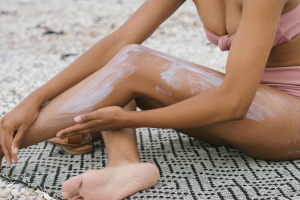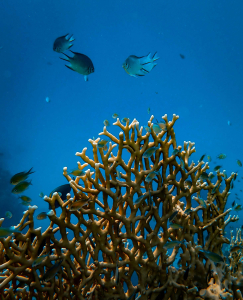
In recent years, “clean beauty” has become a global trend, transitioning from a niche sector to one of the most popular trends worldwide. New eco-consumers are increasingly aware of the importance of the ingredients in the products they use daily and their impact on the environment. In this context, there has been a growing interest in “reef-safe” cosmetics, which do not harm coral reefs and marine ecosystems. While claims like “paraben-free” or “fragrance-free” seem to be declining, “plastic-free” or “reef-safe” claims are on the rise. Thus, attention to the ecosystem is becoming more of a priority for a wide range of consumers, international institutions, and the scientific community, recognizing the importance of preserving and protecting our precious marine environment.
Coral Bleaching
One of the most concerning phenomena is coral bleaching. This process occurs when corals under stress expel the symbiotic algae (zooxanthellae) that provide them with nutrients through photosynthesis. Causes of stress can vary, including changes in water temperature, increased ocean acidity, intensified solar radiation, and the presence of pollutants like herbicides and oil spills. If the stress persists, the coral can no longer feed and may die. Coral bleaching not only directly threatens the survival of these marine organisms but also has devastating impacts on the surrounding ecosystem. The loss of corals reduces biodiversity, affects the habitat of numerous fish and crustaceans that depend on coral reefs, and can increase the risk of coastal damage from waves and storms.
“Physical” and “Chemical” Sunscreens: Which Are More Impactful on the Marine Environment?
The term “physical” or “mineral” filters generally refers to inorganic UV filters that act by reflecting UV radiation, while “chemical” filters refer to synthetic organic compounds that absorb UV radiation and disperse it as heat. In terms of human health safety, for example taking the EU Cosmetics Regulation as a reference, all UV filters, whether physical or chemical, are subject to rigorous safety assessments and only those approved as safe and listed in Annex VI of the Regulation can be included in cosmetic products.
 However, chemical filters have been subject to increasing scrutiny due to their potential environmental impact. Recent studies have detected the presence of some of these filters in marine waters, citing them as possible causes of coral bleaching, with oxybenzone being the main culprit. In response to these concerns, some governments, such as Hawaii’s, have banned the use of certain synthetic UV filters and are proposing additional bans for other substances. These actions are also influencing other jurisdictions to follow the same direction.
However, chemical filters have been subject to increasing scrutiny due to their potential environmental impact. Recent studies have detected the presence of some of these filters in marine waters, citing them as possible causes of coral bleaching, with oxybenzone being the main culprit. In response to these concerns, some governments, such as Hawaii’s, have banned the use of certain synthetic UV filters and are proposing additional bans for other substances. These actions are also influencing other jurisdictions to follow the same direction.
A possible alternative for formulators is represented by mineral UV filters, such as titanium dioxide and zinc oxide. Although they may seem more environmentally friendly due to their natural origin, they too can cause coral bleaching under certain conditions, as highlighted by specific studies.
However, the limited availability of studies and the complex dynamics of the marine environment make it difficult to establish a definitive relationship between exposure to sunscreens and coral bleaching. The concentrations of UV filters in the real marine environment are often lower than estimates but can obviously increase in crowded places like beaches. The issue of sunscreen protection and its environmental impact is truly complex and requires further research to fully understand the dynamics at play and develop solutions that ensure both skin protection and marine ecosystem preservation.
Is There a “Perfect” UV Filter?
This raises some questions: Is there a solution that meets the need to protect the skin from sun damage without compromising the ecosystem? And is it possible to support the claim “reef-safe” for a sunscreen? Due to the limited research available, there is still no scientific consensus on the definition of a “reef-safe” sunscreen. Nevertheless, tools have already been developed to assess the environmental impact of sunscreens, considering parameters such as biodegradability and aquatic toxicity. These tools can be useful for evaluating existing and future formulations to minimize negative environmental impact.
Guidelines for Manufacturers, Consumers, and Local Institution
The International Coral Reef Initiative (ICRI) has outlined a series of recommendations to guide companies in respecting the marine environment:
- Encourage the production of reef-friendly sunscreens: It is important that studies on the impact of sunscreens continue to support possible regulatory changes, and that companies are encouraged to invest in alternative technologies.
- Promote the use of sea-friendly sun protection methods: It is essential to raise user awareness about the environmental impact of sunscreens, encouraging them to use alternative protections such as shade and protective clothing.
- Regulate the sale and use of sunscreens with harmful ingredients: Some marine areas apply regulations that ban sunscreens with harmful ingredients, promoting the use of sunscreens with mineral filters.
- Apply bottom-up pressure for greener sunscreens: The ICRI suggests raising public awareness to push manufacturers to formulate sunscreens with reduced environmental impact.
- Introduce financial disincentives: Taxing sunscreens with substances harmful to the marine environment could encourage consumers to prefer low-impact products, although the effectiveness of this approach is not always guaranteed.
How Should Cosmetic Companies Adapt?
For companies wishing to formulate products that are safe for the marine ecosystem and meet consumers’ expectations for naturalness and sustainability, it is important to balance the benefits of sunscreens in protecting the skin with the risk of harming the marine environment.
 It is important to emphasize that substances, regardless of their origin, can cause negative impacts on ecosystems. Therefore, risk assessment should be addressed scientifically, based on toxicity and exposure levels, and the resulting risk management should be proportionate. To truly reduce ecosystem damage, claims such as “reef-safe” should be supported by solid evidence. Formulas should be tested under conditions similar to those of the real marine environment, also evaluating the long-term effects of exposure to substances present in the products.
It is important to emphasize that substances, regardless of their origin, can cause negative impacts on ecosystems. Therefore, risk assessment should be addressed scientifically, based on toxicity and exposure levels, and the resulting risk management should be proportionate. To truly reduce ecosystem damage, claims such as “reef-safe” should be supported by solid evidence. Formulas should be tested under conditions similar to those of the real marine environment, also evaluating the long-term effects of exposure to substances present in the products.
NATRUE’s Support
To formulate truly natural and sustainable cosmetics, a reliable guide is represented by the standards of certified natural and organic cosmetics, such as the NATRUE label. Its strict requirements ensure that cosmetics bearing the label are genuinely natural and organic, strongly limiting the presence of synthetic substances and mandating the use of mineral UV filters like titanium dioxide and zinc oxide.
NATRUE certification ensures that products have been checked and validated by third-party bodies according to the standard’s criteria, thus combating greenwashing and supporting companies engaged in sustainability and environmental compatibility. To ensure that sunscreens respect the sea and meet the growing consumer expectations for naturalness and sustainability, companies can rely on a rigorous standard like NATRUE and its international scheme active since 2008 and well established in major global markets. For more information on the criteria, products, and raw materials certified by NATRUE, you can visit the website www.natrue.org.

Article written by Diana Malcangi, NATRUE Scientific and Regulatory Consultant. It was originally published in Italian on Mabella (available here)



 Deutsch
Deutsch
 English
English
 Español
Español
 Italiano
Italiano